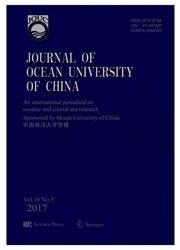

 中文摘要:
中文摘要:
在来自大河的淡水输入的突然的变化通常在沿海的水环境暗示政体移动。在在 Bohai 的黄河水的年龄的一个水规定事件的影响用面向成分的年龄和住处时间理论被建模更好由于人的活动在水动力学领域的环境功能理解变化。在 Laizhou 海湾,中央盆,和 Bohai 海峡的水年龄是敏感的浇规定。在那些区域的表面年龄能到大约 300 天减少,特别地在 7 月,和年龄层化也被加强。在在在在在在 climatological 下面的水年龄的衰落前的七月初的水年龄的衰落的水规定事件罐头结果调节(没有规定事件) 到在中央盆和 Laizhou 海湾的大约 1 和 5 个月分别地。在沿海的发行量的变化由于水规定事件是为在黄河水年龄的变化的主要原因。高黄河流动率能提高密度流动并且因此,减少黄河水的年龄。一个单个水规定事件的随后的影响能在不同分区持续大约 1.0 ~ 4.0 年。
 英文摘要:
英文摘要:
Abrupt changes in freshwater inputs from large rivers usually imply regime shifts in coastal water environments. The influence of a water regulation event on the age of the Yellow River water in the Bohai was modeled using constituent-oriented age and residence time theory to better understand the change in the environmental function of the hydrodynamic field owing to human activities. The water ages in Laizhou Bay, the central basin, and the Bohai strait are sensitive to water regulation. The surface ages in those areas can decrease by about 300 days, particularly in July, and the age stratification is also strengthened. A water regulation event can result in declines in the water age in early July ahead of declines in the water age under climatological conditions(without the regulation event) by about 1 and 5 months in the central basin and Laizhou Bay, respectively. The change in the coastal circulation due to the water regulation event is the primary reason for the change in the Yellow River water age. The high Yellow River flow rate can enhance the density flow and, therefore, reduce the age of the Yellow River water. The subsequent impact of a single water regulation event can last about 1.0 to 4.0 years in different subregions.
 同期刊论文项目
同期刊论文项目
 同项目期刊论文
同项目期刊论文
 期刊信息
期刊信息
